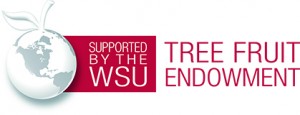Written by Achour Amiri, Plant Pathology, Washington State University, August 4, 2025
Background
Rot pathogens can undergo multiple infection cycles during the growing and storage seasons, increasing the risk of disease outbreaks in storage, particularly in long-term storage. Addressing the problem early in the orchard, combined with careful harvest practices and rigorous postharvest sanitation, is key to reducing losses. Below are some practical tips and reminders to help improve rot control and maximize packout.
Orchards matter
Although decay symptoms typically appear months after harvest, up to 80% of fungal infections are believed to occur in the orchard. Proactive orchard management is essential to reduce postharvest losses. Key practices include:
- Sanitation: Flail-mow orchard floors to remove organic debris such as fallen leaves and fruit, which serve as reservoirs for fungal pathogens.
- Canker and Dieback Monitoring: Regularly scout for cankers and twig diebacks. High incidence increases disease risk. Prune affected branches and apply fungicides when necessary. Manchurian crabapple pollinizers can increase the risk of certain diseases such as speck rot.
- Fungicide Timing and Resistance Management: Apply effective fungicides at critical growth stages. Be aware of resistance issues; knowing the type and level of fungicide resistance in your orchard helps avoid using ineffective products.
- Application Timing: Early-season sprays (e.g., at petal fall and fruit set) help suppress latent infections. Preharvest applications (7 to 0 days before harvest) protect ripening fruit, which are more vulnerable to infections.
- Fungicide Options:
- Conventional orchards: Merivon, Topsin-M, and OSO remain effective options. Elevate is an additional preharvest option for pear growers.
- Organic orchards: Cueva, AVIV, Serenade OPTI, and Cinnerate have demonstrated higher efficacy in recent trials.
- Overhead cooling: Prolonged overhead cooling can create ideal conditions for fungal infections. To reduce risk: 1) Use cycled cooling events (e.g., 15 minutes wet, 45 minutes dry) to allow foliage and fruit to dry between cycles, 2) Time fungicide applications around cooling events to maximize effectiveness, and 3) be especially cautious with decay-prone cultivars like Honeycrisp and Gala, which are more susceptible under extended wet conditions.
Harvest Best Practices to Minimize Postharvest Decay
- Use Clean, Sanitized Bins: Dirty bins containing mummified fruit or residues can compromise the effectiveness of pre- and postharvest fungicides. Always start with clean bins.
- Delay Bin Placement: Set out bins as close to harvest time as possible to minimize contamination from airborne fungal spores.
- Harvest at Optimal Maturity: Avoid delays, over-mature fruit is significantly more susceptible to decay. Research shows that a one-week delay can increase decay by up to 30%.
- Prevent Fruit Injury: Minimize wounding during harvest and handling. Many pathogens, including Penicillium and Mucor, require wounds to infect fruit.
- Sort and Remove Damaged Fruit: Discard fruit with punctures, splits, or other injuries before storage. This is especially important for sensitive cultivars like Honeycrisp and SugarBee.
- Adopt a ‘Zero Unharvested Fruit’ Policy: Remove all fruit from trees to eliminate inoculum sources for the next season.
Postharvest Practices to Minimize Decay
- Sanitize Storage Rooms: Fungal spores can persist on walls, floors, and in the air between seasons. Thoroughly clean and sanitize storage rooms before storing fresh fruit—just as with harvest bins. Use detergents and sanitizers to wash surfaces and eliminate residual spores.
- Fogging for Air Sanitation: Treat the air with sanitizers such as peracetic acid (PAA) or ozone to reduce airborne spore loads.
- Timely Fungicide Application: Apply postharvest fungicides as soon after harvest as possible to ensure maximum protection.
- Rotate Fungicides: Alternate fungicides annually to slow the development of resistance.
- Improve Fungicide Efficacy: Sanitize drencher solutions regularly and space bin stacks when fogging to ensure even coverage.
- Manage High-Risk Lots: Store fruit from orchards with a history of disease separately and monitor closely to reduce potential spread.
- Clean Packing Line Water: When pre-sizing fruit, ensure water is free of fungal spores to prevent cross-contamination.
Contact
Achour Amiri
Washington State University
a.amiri@wsu.edu
509-393-4058
Fruit Matters articles may only be republished with prior author permission © Washington State University. Reprint articles with permission must include: Originally published by Washington State Tree Fruit Extension Fruit Matters at treefruit.wsu.edu and a link to the original article.
Use pesticides with care. Apply them only to plants, animals, or sites listed on the labels. When mixing and applying pesticides, follow all label precautions to protect yourself and others around you. It is a violation of the law to disregard label directions. If pesticides are spilled on skin or clothing, remove clothing and wash skin thoroughly. Store pesticides in their original containers and keep them out of the reach of children, pets, and livestock.
YOU ARE REQUIRED BY LAW TO FOLLOW THE LABEL. It is a legal document. Always read the label before using any pesticide. You, the grower, are responsible for safe pesticide use. Trade (brand) names are provided for your reference only. No discrimination is intended, and other pesticides with the same active ingredient may be suitable. No endorsement is implied.

